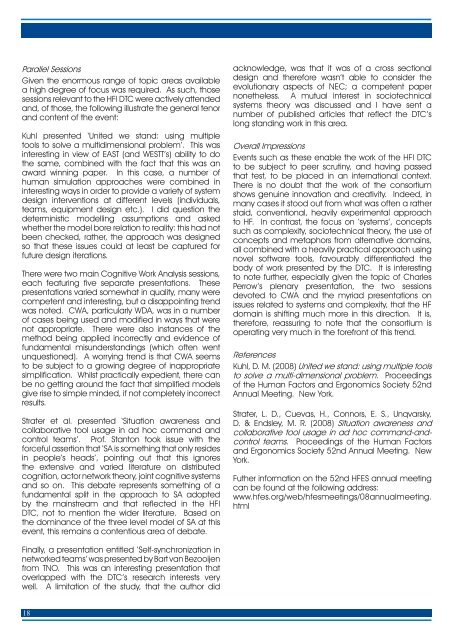Frontline Issue 09 - Human Factors Integration Defence Technology ...
Frontline Issue 09 - Human Factors Integration Defence Technology ...
Frontline Issue 09 - Human Factors Integration Defence Technology ...
You also want an ePaper? Increase the reach of your titles
YUMPU automatically turns print PDFs into web optimized ePapers that Google loves.
Parallel SessionsGiven the enormous range of topic areas availablea high degree of focus was required. As such, thosesessions relevant to the HFI DTC were actively attendedand, of those, the following illustrate the general tenorand content of the event:Kuhl presented ‘United we stand: using multipletools to solve a multidimensional problem’. This wasinteresting in view of EAST (and WESTT’s) ability to dothe same, combined with the fact that this was anaward winning paper. In this case, a number ofhuman simulation approaches were combined ininteresting ways in order to provide a variety of systemdesign interventions at different levels (individuals,teams, equipment design etc.). I did question thedeterministic modelling assumptions and askedwhether the model bore relation to reality: this had notbeen checked, rather, the approach was designedso that these issues could at least be captured forfuture design iterations.There were two main Cognitive Work Analysis sessions,each featuring five separate presentations. Thesepresentations varied somewhat in quality, many werecompetent and interesting, but a disappointing trendwas noted. CWA, particularly WDA, was in a numberof cases being used and modified in ways that werenot appropriate. There were also instances of themethod being applied incorrectly and evidence offundamental misunderstandings (which often wentunquestioned). A worrying trend is that CWA seemsto be subject to a growing degree of inappropriatesimplification. Whilst practically expedient, there canbe no getting around the fact that simplified modelsgive rise to simple minded, if not completely incorrectresults.Strater et al. presented ‘Situation awareness andcollaborative tool usage in ad hoc command andcontrol teams’. Prof. Stanton took issue with theforceful assertion that ‘SA is something that only residesin people’s heads’, pointing out that this ignoresthe extensive and varied literature on distributedcognition, actor network theory, joint cognitive systemsand so on. This debate represents something of afundamental split in the approach to SA adoptedby the mainstream and that reflected in the HFIDTC, not to mention the wider literature. Based onthe dominance of the three level model of SA at thisevent, this remains a contentious area of debate.acknowledge, was that it was of a cross sectionaldesign and therefore wasn’t able to consider theevolutionary aspects of NEC; a competent papernonetheless. A mutual interest in sociotechnicalsystems theory was discussed and I have sent anumber of published articles that reflect the DTC’slong standing work in this area.Overall ImpressionsEvents such as these enable the work of the HFI DTCto be subject to peer scrutiny, and having passedthat test, to be placed in an international context.There is no doubt that the work of the consortiumshows genuine innovation and creativity. Indeed, inmany cases it stood out from what was often a ratherstaid, conventional, heavily experimental approachto HF. In contrast, the focus on ‘systems’, conceptssuch as complexity, sociotechnical theory, the use ofconcepts and metaphors from alternative domains,all combined with a heavily practical approach usingnovel software tools, favourably differentiated thebody of work presented by the DTC. It is interestingto note further, especially given the topic of CharlesPerrow’s plenary presentation, the two sessionsdevoted to CWA and the myriad presentations onissues related to systems and complexity, that the HFdomain is shifting much more in this direction. It is,therefore, reassuring to note that the consortium isoperating very much in the forefront of this trend.ReferencesKuhl, D. M. (2008) United we stand: using multiple toolsto solve a multi-dimensional problem. Proceedingsof the <strong>Human</strong> <strong>Factors</strong> and Ergonomics Society 52ndAnnual Meeting. New York.Strater, L. D., Cuevas, H., Connors, E. S., Unqvarsky,D. & Endsley, M. R. (2008) Situation awareness andcollaborative tool usage in ad hoc command-andcontrolteams. Proceedings of the <strong>Human</strong> <strong>Factors</strong>and Ergonomics Society 52nd Annual Meeting. NewYork.Futher information on the 52nd HFES annual meetingcan be found at the following address:www.hfes.org/web/hfesmeetings/08annualmeeting.htmlFinally, a presentation entitled ‘Self-synchronization innetworked teams’ was presented by Bart van Bezooijenfrom TNO. This was an interesting presentation thatoverlapped with the DTC’s research interests verywell. A limitation of the study, that the author did18
















